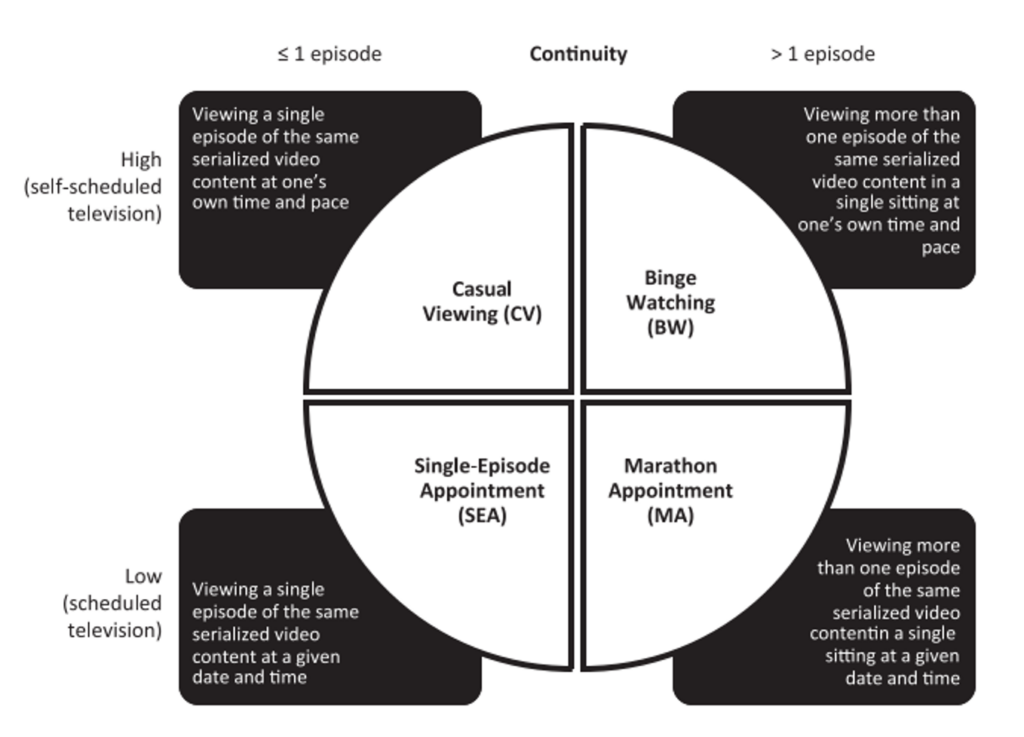WHAT EXACTLY IS BINGE WATCHING AND HOW IT DIFFERS FROM CASUAL WATCHING?
The technological revolution has changed the way people consume video content, making them feel like they’re in control of the time, content, place, and device they use to watch. Is that the case in reality? Some researchers claim that binge-watching was sparked by this, where several episodes of a program are watched in a single sitting. What exactly is binge watching?
There is no widely accepted definition of “binge-watching” (BW). Still, some efforts are being made to conceptualize it. For example, Merikivi and colleagues (2019) proposed that BW can be defined as watching more than one episode of the same serialized video content in a single sitting at one’s own pace and time. They suggest paying attention to BW as a product of technological evolution, representing a breakaway from scheduled television to self-scheduled watching with greater viewer autonomy, when user is allowed to decide on when and how much to use media. Authors also are talking about continuity and completion of watching. Continuity refers to watching episodes in one sitting without interruptions such as commercial breaks during and between episodes. That is, when viewers are BW, they want to consume episodes of a specific show in a continuous flow to enjoy a freedom as a break from scheduled television.
Completion emphasizes a desire for any definitive knowledge on how the given television show ends. Viewers expect to see season and show finales, so completion provides a foundation for BW. Completion does not always necessitate continuity, as long as a season is “consumed within one week,” but it can sometimes necessitate unnecessarily extreme sittings or sittings that are physically impossible.
There are four distinct viewing practices described by the quadrant framework (Merikivi et al., 2019): BW which differs from casual (self-scheduled single-episode sessions) viewing (CV), as well as from scheduled single-episode appointments (SEA) and multiepisode or marathon appointments: (MA).

Netflix is the most popular streaming service for binge-watching and it has restructured this experience by requiring no viewer interaction. Researcher Önder Kulak (2020) offered to separate in the Netflix binge model three main stages: pre-play stage, play stage and post- play stage.
Usually binge process Netflix starts with the publication of the whole season of a series. Netflix then continues to publish until the new season of the relevant series is approved and made ready. After opening the series to access, the interface begins to introduce it to the viewer under the title of recommendations. The viewer, who follows another series at that time, is attempted to be persuaded for the series through some pieces from the scenes. The pre-play stage is followed by the play stage if the viewer is persuaded to watch the series. The viewer thus integrates attention with the presented plot together with the first episode. When the end of the first episode comes, the post-play stage arises without asking the viewer. It represents a bridge between the episodes through the post-play and skip-intro functions, which provide the viewer with the opportunity to continue with the next episode after a few seconds. Therefore, the viewer becomes able to watch the series as monolithic flow.
IS BW ADDICTION?
The term “binge” reminds a connection with some disorders, such as binge-eating, binge-drinking, or other excessive usage behaviors, like playing video games, which is one reason for the negative connotation of BW. Related to that there is ongoing academic discussion about the potential risks associated with binge-watching. We would like to introduce with the research done by group of researchers in Switzerland (Ort et al., 2021). Researchers investigated the effect of (1) the frequency of high-dosage consumption of TV series and (2) the motives that drive this behavior on problematic viewing habits. Research results supports the notion that there is indeed a relationship between binge-watching frequency and tendencies to develop problematic viewing habits.
A first important finding of this study was that certain motives can facilitate the development of problematic viewing habits. The emerging pattern aligns with the continuum between recreative, risky, and addictive behaviors. While recreational motives such as entertainment and relaxation even reduce indicators for detrimental habits, motives that could be interpreted as riskier are positively related to problematic usage behavior. In particular, people watching series for motives of escapism, loneliness, stimulation, social interaction, and learning also report stronger tendencies for problematic viewing behaviors.
Another important finding is that only those latter motives significantly interact with the frequency of binge viewing sessions. Thus, while relaxation and entertainment seem to be unproblematic and rather recreational motives regardless of binge-watching frequency, the negative impact of all other (more risky) motives increases with the frequency of use.
The nature of motives identified as proliferating problematic viewing behavior is different as not all of them would intuitively be linked to problematic media use, such as learning and social interaction. However, although TV series use provides an effortless and inspiring way of learning things about life, successfully obtaining a gratification through this behavior has been found to contribute to its addictiveness. Concerning social interaction, socialization motives and group dynamics have previously been linked to other excessive behaviors. In this sense, perceived pressure to be up to date regarding important series content in one’s social group could be a potential driver. Relatedly, fear of missing out (FOMO, i.e., an apprehension associated with the fear that other people are having a pleasurable experience that one is not a part of) could also be an explanation for engaging in excessive viewing behavior, as it boosts the pace of media consumption.
To summarise, the results suggest that binge-watching should not generally be considered as problematic behavior—at least if it only happens from time to time. This notion is further supported by findings that motives like entertainment and relaxation even show a negative relationship with the scores for problematic use. Based on that, researchers consider binge-watching as a recreational activity that can become problematic under the specific circumstances, but is not problematic per se.
⬇️ REFERENCES:
- Kulak, Ö. (2020). The binge-watching experience on Netflix. Journal of Art, Design & Science, 24, 45-55. doi: 10.17484/yedi.730496
- Merikivi, J., Bragge, J., Scornavacca, E., and Verhagen, T. (2019). Binge-watching serialized video content: Transdisciplinary review. Television and Media, 1-15. doi: 10.1177/1527476419848578
- Ort A, Wirz, DS., Fahr, A. (2020). Is binge-watching addictive? Effect of motives for TV series use on relationship between excessive media consumption and problematic viewing habits. Addictive Behav Rep. (2021) 13:100325. doi: 10.1016/j.abrep.2020
